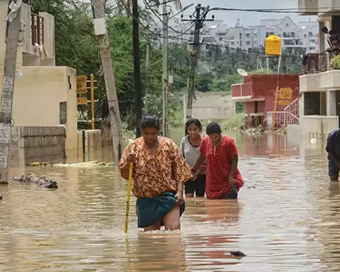 PM Modi visit USA
PM Modi visit USA Only the mirror in my washroom and phone gallery see the crazy me : Sara Khan
Only the mirror in my washroom and phone gallery see the crazy me : Sara Khan Karnataka rain fury: Photos of flooded streets, uprooted trees
Karnataka rain fury: Photos of flooded streets, uprooted trees Cannes 2022: Deepika Padukone stuns at the French Riviera in Sabyasachi outfit
Cannes 2022: Deepika Padukone stuns at the French Riviera in Sabyasachi outfit Ranbir Kapoor And Alia Bhatt's Wedding Pics - Sealed With A Kiss
Ranbir Kapoor And Alia Bhatt's Wedding Pics - Sealed With A Kiss Oscars 2022: Every Academy Award Winner
Oscars 2022: Every Academy Award Winner Shane Warne (1969-2022): Australian cricket legend's life in pictures
Shane Warne (1969-2022): Australian cricket legend's life in pictures Photos: What Russia's invasion of Ukraine looks like on the ground
Photos: What Russia's invasion of Ukraine looks like on the ground Lata Mangeshkar (1929-2022): A pictorial tribute to the 'Nightingale of India'
Lata Mangeshkar (1929-2022): A pictorial tribute to the 'Nightingale of India' PM Modi unveils 216-feet tall Statue of Equality in Hyderabad (PHOTOS)
PM Modi unveils 216-feet tall Statue of Equality in Hyderabad (PHOTOS)Hockey India has announced a 54-member core probable squad for the upcoming senior men’s
- Satwik-Chirag return as BAI names 14-strong squad for BWF Sudirman Cup Finals 2025
- Men’s Sr Hockey Nationals to be played in division-based format from April 4
- Mensik denies Djokovic 100th title in Miami final
- KIPG: Son of a vegetable vendor, Bihar’s Jhandu Kumar eyes Worlds, 2028 Paralympics
- Hardik Singh credits hard work and team unity for receiving HI Midfielder of the Year award
How India lost an island chain in the Bay of Bengal Last Updated : 05 Apr 2017 03:21:30 PM IST 
file photo
A chain of islands that once existed in the Bay of Bengal now lies buried under water, according to a new study by Indian oceanographers.
A chain of islands that once existed in the Bay of Bengal now lies buried under water, according to a new study by Indian oceanographers.
If this long island chain that stretched from north to south had not been swallowed by the sea, it could have offered a natural barrier against tsunamis like the one that killed thousands in 2004, they say.
These islands had existed during the Late Cretaceous age -- about 68 to 80 million years ago, according to their report in the journal Current Science.
Currently they lie as a "ridge" buried beneath the enormously thick sediment discharged by the Ganges and Brahmaputra river systems.
The ridge, known as Eighty-five East Ridge -- so named because it runs nearly parallel to the 85 degree east longitude -- extends north-south for about 2,500 km from the Mahanadi Basin in the north Bay of Bengal to the Afanasy Nikitin Seamount in the equatorial Indian Ocean.
That part of the ridge in the Bay of Bengal that once hosted the islands "is completely buried under the Bengal Fan sediments," says the report by K.S. Krishna at the National Institute of Oceanography in Goa and his co-workers.
According to the authors, "In spite of more than three decades of research carried out by scientists from different countries, the origin of the ridge still remains a conundrum." In their research, they studied the seismic structure of the ridge.
Their study showed that at the time of ridge emplacement about 80 million years ago, the ocean floor was around four kilometres below sea level and about 500 to 1,000 metres of the ridge summit existed above sea level.
The researchers say their study has provided strong evidence to indicate that the ridge peak remained above sea level as an island for a short period during the Late Cretaceous age before it subsided "due to thermal subsidence and volcanic load".
It may have taken about 6 to 12 million years for all the peaks of the ridge to subside below the sea level, says the report. "The processes of thermal subsidence and sedimentation load together placed the island chain below the sea level, and then below the thick pile of Bengal Fan sediments."
In conclusion, the authors say that "the 85 deg.E Ridge remained as a series of island mounts with variable reliefs in the middle of the Bay of Bengal during the Late Cretaceous and got completely submerged below the sea level around 68 million years ago".
"In case such submergence had not happened, the 85 deg.E Ridge would have remained an island chain analogous to present day Maldives Islands in the Indian Ocean and Hawaiian Islands in the Pacific Ocean," they say.
IANS For Latest Updates Please-
Join us on
Follow us on








172.31.16.186







